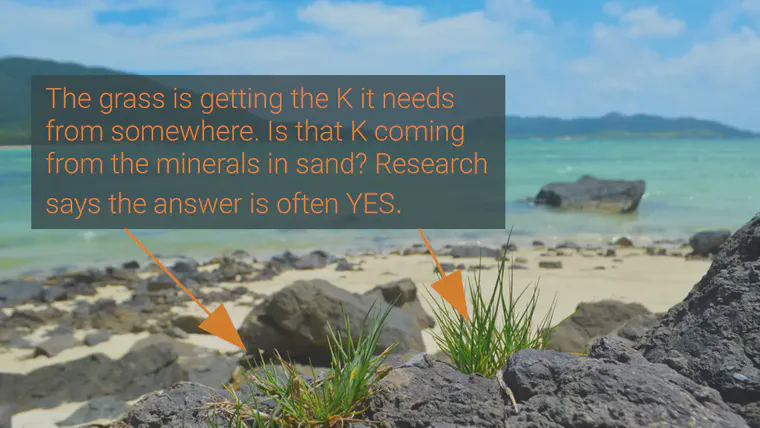A potassium reserve in the soil: non-exchangeable and mineral K
This is a good one. Sand rootzones with low cation exchange capacity (CEC) don’t have a large amount of exchangeable potassium (K), for the simple reason that sands have a low CEC. At the same time, among the essential elements, K is used in relatively large amounts; more K is used by the grass than any other element except for nitrogen.

In response to another post about K, Greg Aspenson asked about K reserves.

My answer was basically, “great question, yes, NEK and mineral K are a reserve, and I’ll blog about it.”
Restating the problem
I’m concerning myself to turf growing in sand. The problem is, sand has low CEC so there is not going to be much exchangeable K. Yet the grass uses a lot of K compared to other elements, so one naturally wants to be sure the grass is supplied with enough K. How can a turf manager navigate this without making egregious mistakes? In this case massive over-application of K fertilizer is one egregious mistake, and in the other direction, turf that suffers from K deficiency is another egregious mistake.
I describe a solution at the end, but first, some surprising research results.
Head-shaking results
What would you expect to happen if you took eight different sands from around the USA and grew Penncross creeping bentgrass in them, if those sands all had negligible levels of exchangeable K? This experiment happened, and the sands had K ranging from the lowest one at 2 ppm to the highest at 16 ppm.1 That’s not very much K at all.
What would you expect to happen if bentgrass was grown in those sands in many different pots? Some never had K fertilizer applied, and some did have K fertilizer applied. Remember, these are quite low values of K in the soil. Of the eight different sands, how many do you think would grow more with the added K fertilizer? All of them? Half of them?
The correct answer is one. Only a single one of those sands (which had soil test K of 4 ppm) had higher clipping yield when K fertilizer was added.
What about roots? In this case, three out of the eight sands had more root growth when K fertilizer was added.
The experiment, of course, is Dest and Guillard’s “Bentgrass response to K fertilization and K release rates from eight sand rootzone sources used in putting green construction.”
In the results, they wrote:
The amount of K removed by the bentgrass was greater than the available K on the cation exchanges sites on all rootzone sources except for the Kansas rootzone source. This indicates that a substantial amount of K uptake by the bentgrass is coming from structural forms with as much as 9 times the K taken up by bentgrass than on the exchange sites …
The results of the study suggest that release of K from primary minerals contained in some sands used in rootzone mixes is occurring at rates which satisfy bentgrass requirements for K.
This is head-shaking because the soil test K in those sands is low, the grass is using more K than is present on the exchange sites, and the grass is also not responding to K fertilizer addition in more than half of those sands.
That’s the first head-shaking result. How about this for a second one. This is Bier et al.’s “A long term evaluation of differential potassium fertilization of a creeping bentgrass putting green.”
‘Penn A4’ creeping bentgrass was grown in a sand rootzone for six years and was maintained as a putting green. Some plots of this green got K fertilizer, and some did not.
After six years,
It was surprising to find that after six growing seasons of not adding K to control treatments, while continually removing K (via clipping removal), that visual K deficiency symptoms were not observed and yield was unaffected among treatments.
They also measured total soil K.
Using total soil K, we observed that the total soil K content was increasing by about 50 mg kg-1 soil yr.-1, despite regular removal of K in clippings.
They found that this increase in total K was coming from the mineral K applied in topdressing sand, and that this mineral K was supplying enough to meet all the plant requirements for K.
When one thinks about the results of these experiments, it’s apparent that routine soil tests for exchangeable K will often identify sand rootzones as likely to respond to K fertilizer, when in fact many of these sand rootzones may not respond to K fertilizer.
A practical solution
If I test a site for the first time, I’ll be conservative and make a recommendation based on the MLSN guidelines. I’m trying to prevent two egregious mistakes, and this does that by preventing deficiency and also avoiding massive over-application of K.
After that initial recommendation, I’ll look at how K changes in the soil over time, and compare that to the expected change in soil K over time given the quantity of N and K fertilizer that have been applied. Future recommendations are then made based on an idiosyncratic method2 that I have yet to formalize, in which I adjust the K fertilizer recommendation based on whether the soil K is dropping more or less than expected, and on the grass type.
This was by 1 N ammonium acetate extraction; expect Mehlich 3 values for K to be about 20% higher. ↩︎
Clearly a nice project for me to work on, to formalize this. Mehlich 3 extracts more K than 1 N ammonium acetate, so there is an opportunity to use Mehlich 3 K as crude index of NEK and K supplying power of sand rootzones. I think. ↩︎